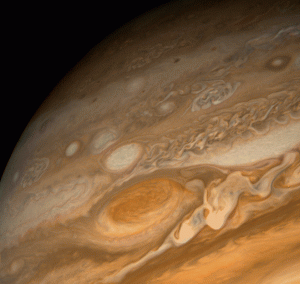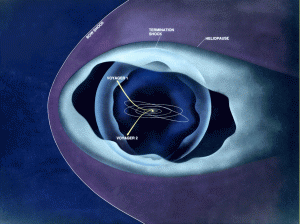[ad_1]
What were the chances, back in in 1977, that two little Voyager probes would be able to survive the perils of travelling through our solar system and continue to function usefully for 40 years (or more)?
It’s too easy to be blasé about space exploration and all that has been achieved since the second half of the 20th century. And yet it has also become a cliché to assert that the technology that took the Apollo 11 mission to the moon and back eight years earlier was no more powerful than a pocket calculator or a mobile phone.
Launching Voyager 1 and 2
The launch of Voyagers 1 and 2 began what has become a detailed exploration of our solar system. Voyager 2 was first up, on 20 August 1977, and Voyager 1 followed on 5 September. They provided photographs that fired the imagination of generations of people to seek careers in astronomy and space science and engineering.
NASA’s timeline lists the milestones with characteristic understatement:
- 1979 Mar 5 – Voyager 1 makes its closest approach to Jupiter
- 1979 July 9 – Voyager 2 makes its closest approach to Jupiter
- 1980 Nov – 12 Voyager 1 flies by Saturn / Voyager 1 begins its trip out of the Solar System
See the full list of Voyager milestones here.
The missions
The twin craft were initially intended to study Jupiter and Saturn, but their mission was subsequently extended three times as, adding Neptune and Uranus to their schedule, they continued to be able to collect and return useful scientific data from the four giant planets and 48 of their moons.
Now Voyager 1 is believed to have made it to interstellar space in August 2012, with Voyager 2 following a few years behind it.
The science payload of the original mission consisted of 10 instruments (11 including radio science), and although only five are still operational, all are “working well and are capable of continuing operations”, according to NASA. That takes definitions of ‘high reliability’ to a whole new level.
“The mission objective of the Voyager Interstellar Mission (VIM) is to extend the NASA exploration of the solar system beyond the neighbourhood of the outer planets to the outer limits of the Sun’s sphere of influence, and possibly beyond,” says NASA.
“As of February 2017, Voyager 1 was at a distance of 20.6 billion kilometers from the sun and Voyager 2 at a distance of 17 Billion kilometers,” it said.
The tech spec
NASA details the systems that keep the spacecraft operational as follows:
- The command computer subsystem (CCS) provides sequencing and control functions. It contains fixed routines such as command decoding and fault detection and corrective routines, antenna pointing information, and spacecraft sequencing information.
- The Attitude and Articulation Control Subsystem (AACS) controls spacecraft orientation, maintains the pointing of the high gain antenna towards Earth, controls attitude manoeuvres, and positions the scan platform.
- Uplink communication is via S-band (16-bits/sec command rate) while an X-band transmitter provides downlink telemetry at 160 bits/sec normally and 1.4kbps for playback of high-rate plasma wave data. All data are transmitted from and received at the spacecraft via the 3.7 meter high-gain antenna (HGA).
- Electrical power is supplied by three Radioisotope Thermoelectric Generators (RTGs). The current power levels are about 315W for each spacecraft. As the electrical power decreases, power loads on the spacecraft must be turned off in order to avoid having demand exceed supply. As loads are turned off, some spacecraft capabilities are eliminated.
Boldly going
NASA says:
“Both Voyagers are headed towards the outer boundary of the solar system in search of the heliopause, the region where the Sun’s influence wanes and the beginning of interstellar space can be sensed.”
“The Voyagers may be the first to pass through this region, which is thought to exist somewhere from 8 to 14 billion miles from the Sun. This is where the million-mile-per-hour solar winds slows to about 250,000 miles per hour—the first indication that the wind is nearing the heliopause. The Voyagers should cross the heliopause 10 to 20 years after reaching the termination shock. They have enough electrical power and thruster fuel to operate at least until 2020. By that time, Voyager 1 will be 13.8 billion miles from the Sun and Voyager 2 will be 11.4 billion miles away.”
“In about 40,000 years, Voyager 1 will drift within 1.6 light-years of AC+79 3888, a star in the constellation of Camelopardalis which is heading toward the constellation Ophiuchus. In about 40,000 years, Voyager 2 will pass 1.7 light-years from the star Ross 248 and in about 296,000 years, it will pass 4.3 light-years from Sirius, the brightest star in the sky.”
Gadget Master salutes the hard work and ingenuity of all those who worked on the projects!
“The Voyagers are destined – perhaps eternally – to wander the Milky Way,” adds NASA, and I think the least we can do is forgive them a little hyperbole.
[ad_2]
Source link


